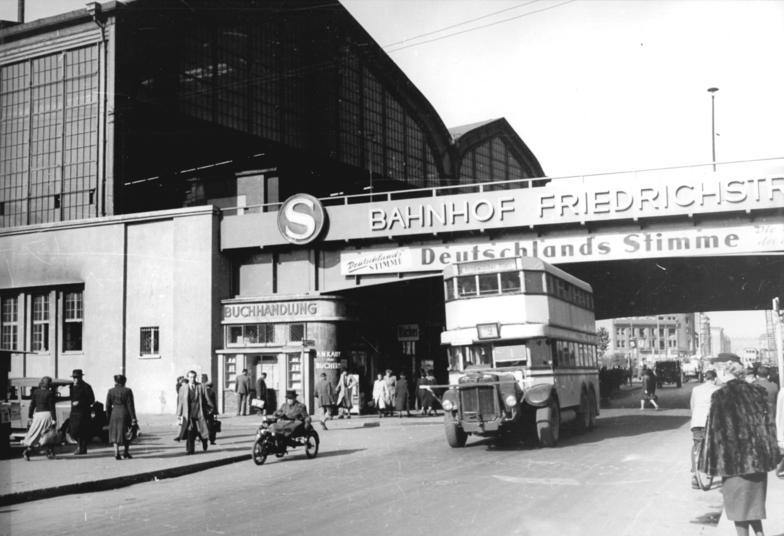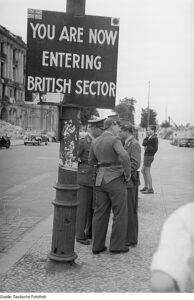When is a train station more than just a mundane bit of transportation infrastructure?
Well, when it’s in Berlin, of course! When you travel to the German capital, you have endless opportunities to reflect on how world changing events sometimes occur in the most bewilderingly ordinary of places, locations you’d likely travel through without ever noticing anything special about the place.
Which brings us to Friedrichstrasse Bahnhof, or train station.
Friedrichstrasse – Really the Most Central of Berlin´s many Railway Stations
If you find yourself here during your stay, you shouldn’t be too surprised. The station lies across the busy Friedrichstrasse, a well-known thoroughfare and gateway to many of the city’s better-known sites. If you do travel through here, you’ll be one of over a quarter million people who do so every 24 hours. However, instead of rushing through on your way to a show or dinner, linger a few moments to think about just where you are. It’s a station with a tremendous story to tell.
Bahnhof Friedrichstrasse was first built in 1878, by an odd coincidence the same year that future Soviet dictator Joseph Stalin was born, who would as the city’s conqueror ride a train from the station here to Potsdam in July 1945. When first erected, Friedrichstrasse was an emblem of the city’s new found power and relevance on the world stage. Passengers using these platforms had easy access to the University, the palaces and the city’s central museums.
Celebrities as well as War Criminals used Friedrichstrasse Station
It’s no wonder then that these well-trod platforms and stairs once saw the likes of Albert Einstein when he was a professor at the University of Berlin, as Humbolt University was once known. Marlene Dietrich used the station many times as did any number of Berlin’s cabaret-going crowd during the roaring years of the 1920s and early 1930s, when Berlin was «dancing on the volcano» and partying as it did so.
Friedrichstrasse station also saw a young Adolf Hiter step off the train for his first ever visit to the Imperial Capital, in 1916, during one of his rare periods of leave from the trenches in World War One. From here, he made a bee line to the museums and even bought a postcard there.

During the Second World War, the station saw off troops headed to the dreaded Eastern Front, and when that front had moved into the city center in April 1945, the station came under deliberate artillery fire from Soviet forces. Several of the groups that escaped from Hitler’s bunker after he shot himself on April 30 1945 also passed over, and under, the bridge here over the river Spree, desperately trying to escape to the north.
During the Cold War: An International Bordercrossing Station
It was the Cold War, however, that saw the station’s days of greatest fame, or infamy, if you prefer. After the sector border was closed by the building of the Wall, Friedrichstrasse become an international border crossing, being the place where tourists from the west were allowed to visit East Berlin. At the same time, it was also a commuter station serving East Berlin, and most bizarrely, at the same time it was both of those things, it was also a transfer station for westerners connecting between two underground lines which went west. Let’s unpack this all a bit.
Let’s start with that bizarre underground connection between a subterranean S-Bahn line and an urban U-Bahn line. Both lines passed under the communist city, emerging in West Berlin. Picture a letter X, with Friedrichstrasse being at the point where the lines cross. Ordinary people commuting to work from one part of West Berlin to another could change trains here without going through passport control. Essentially, you changed trains under a foreign country, while legally never having left your own. This option was only available to westerners.
Two interesting features of the Cold War station grab the attention and show us the sheer weirdness of divided Berlin. Firstly, many western commuters liked transferring underground at Friedrichstrasse because the East Germans had set up an «Intershop» there, a Communist hard currency store, where you could buy cheap DDR products, from snacks to alcohol, for a fraction of what they cost in the West. Cheap corner shop service, provided by a foreign nation and ideological enemy, while on the way home from work. Only in Berlin.
The other interesting thing about this connection was the fact that at the end of the U-Bahn platform was a locked door. Through this door passed secret agents that the DDR passed off into the general crowd of commuters, as a cheap and easy infiltration method. Clearly, the west tried to run counter-intelligence operations here, to see who came out that door, but they were also themselves being watched. Where else but Cold War Berlin could your commute be spiced up by international espionage? Not that you’d have noticed…of course.
Back up at surface level, on the S-Bahn platforms where today trains run normally, a long wall ran down the middle, severing the southern platforms from the northern. Here, passengers from the west existed the train and had to pass down the stairs to border and customs control, a process that could take anything from several minutes to several hours. You had to change a minimum of 20 marks worth of money and you couldn’t take any eastern money out, so you had to spend it. Which could be difficult on a day-visa in the east; there wasn’t that much to buy that cost that much. You can also be sure that the S-Bahn platforms were a hot bed of espionage as well.
If you, having entered the country, now wanted to travel onwards, you were free to renter the station by another door, and board the trains which took you «normally» from Friedrichstrasse to Ostbahnhof, the DDR’s main train station.
What’s left of all this today? We’ll take a look at that in the next article, as it deserves space of its own. But for now, I’m sure you’ll agree that Friedrichstrasse might not be the most beautiful station in the world (it isn’t, I can assure you) but it most certainly is one of the most interesting and played host to more than its fair share of interesting events.
As always, Berlin surprises us with the stories the lie just below the surface. Literally below the surface, in the partial case of Bahnhof Friedrichstrasse!





